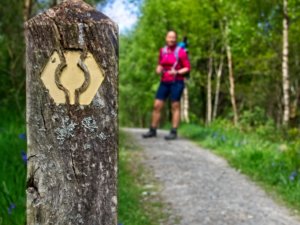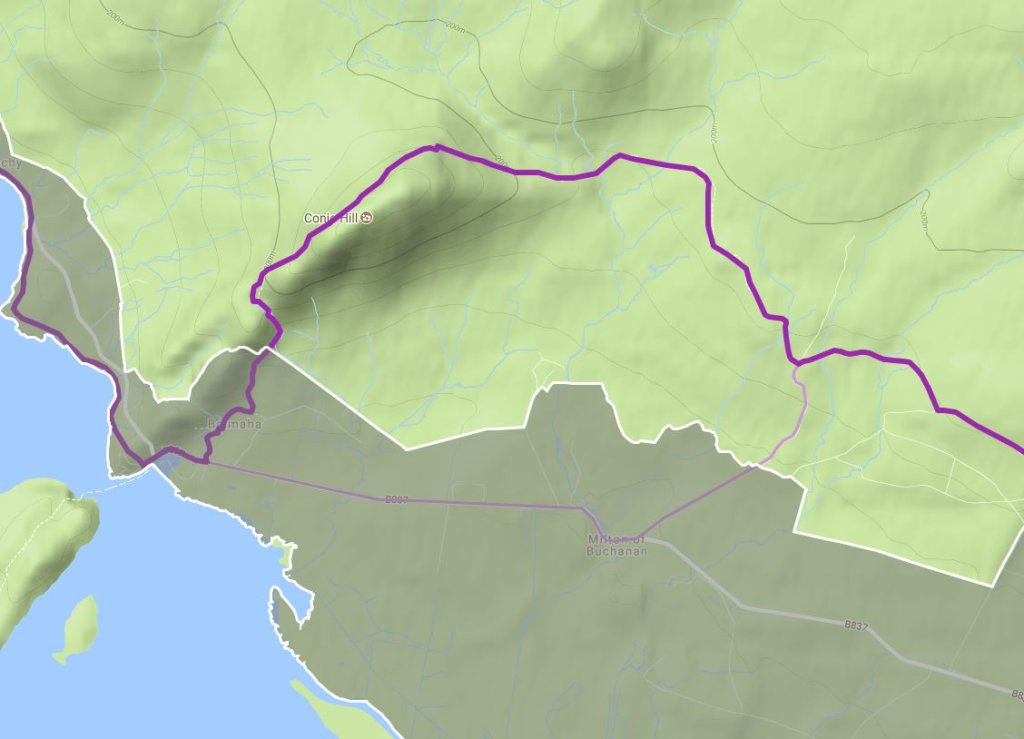Frequently asked questions
Can I cycle the West Highland Way?
You can but it is worth noting that the West Highland Way was designed as a long distance walking route and consequently cyclists will come across terrain, underpasses and gates which were designed specifically for walkers. For example, when the West Highland Way passes under the A82 and West Highland Rail Lines the reduced headroom would require cyclists to dismount. The path between Rowardennan and Inverarnan has some rocky and narrow parts which are not suitable for bikes.
Cycling on hard surfaces, such as wide paths and tracks, causes few problems, however on narrow sections, cycling may cause problems for other people, such as walkers and horse riders. If this occurs, dismount and walk until the path becomes suitable again. Do not endanger walkers and horse riders: give other users advance warning of your presence and give way to them on a narrow path. Take care not to alarm farm animals, horses and wildlife.
Find out more about how to cycle off road and enjoy mountain biking responsibly by visiting this section of the Scottish Outdoor Access Code.
Is wild camping allowed on the Way?
Under the Scottish Outdoor Access Code, wild camping is permitted. This type of camping is lightweight, done in small numbers and only for two or three nights in any one place. Avoid causing problems for local people and land managers by not camping in enclosed fields of crops or farm animals and by keeping well away from buildings, roads or historic structures. Leave no trace by: taking away all your litter, removing all traces of your tent pitch and of any open fire and not causing pollution. Please also note that within the Loch Lomond & The Trossachs National Park camping byelaws operate between March and September .
For further information on your access rights in Scotland visit the Scottish Outdoor Access Code website. This is a very easy to navigate website which will answer any queries you may have.
Can you walk the West Highland Way in winter?
The West Highland Way should only be undertaken in winter by fit walkers with good winter navigation skills. From November to March, winter conditions can be expected and any walker undertaking the route during these months must be fully prepared and properly equipped. When snow falls, all the high ground in the northern half of the Way can be affected. During such times the path can completely disappear, therefore it is essential that walkers have a map and compass and be able to use them. Traversing snow covered slopes can be hazardous and ice axes and crampons are preferred to walking poles at such times. However, many weeks between November and March are fine for walking. Wet and windy days are more common than snowstorms during the milder winters. As the days stretch out in March and with spring approaching it becomes a bit more appealing to get back out walking again. But even in late winter and early spring the weather can throw up some nasty and unpleasant days so preparation and awareness must all be part of the plan. You can read essential advice for winter walking on the Walkhighlands website.
Can I do the West Highland Way on my own?
Yes! For some people it offers great solitude to undertake the trek on your own, but undoubtedly you will make new friends too by the time you reach Fort William. Most people tend to split the route up into similar sections so you often meet the same people each day.
Can I light a fire when camping on the West Highland Way?
Wherever possible, use a stove rather than light an open fire. If you do wish to light an open fire, bring your own wood as cutting trees or collecting dead wood damages the environment and wildlife. Keep fires small, under control and supervised – fires that get out of control can cause major damage, for which you might be liable. Never light an open fire during prolonged dry periods or in areas such as forests, woods, farmland, or on peaty ground or near to buildings or in cultural heritage sites where damage can be easily caused. Heed all advice at times of high risk. Remove all traces of an open fire before you leave. For further information visit the Scottish Outdoor Access Code section on lighting fires. This is a very easy to navigate website which will answer any queries you may have.
Camping byelaws on East Loch Lomond also cover firelighting, please be aware that irresponsible firelighting could lead to a fine.
If you are travelling by plane, there are various outdoor stores in Glasgow or more limited options in Milngavie where you can buy gas canisters, although you should check availability and opening hours.
Do I need to use a map and compass?
The Way is waymarked along its length to help walkers follow the route. You should however be able to read a map and compass to assist with navigation if required.

(credit: Johannes Wollny)
How long does it take to walk the Way?
On average it takes six to seven days to walk the Way making it ideal for a week’s holiday, but there are alternatives available to you. See our itineraries section for ideas on how to split up the route.
When is the best time to walk the Way?
May is the most popular month for walking the West Highland Way; however, this does place pressure on the availability of accommodation. The Way can be walked at any time of the year – Spring and Autumn along the Way are especially beautiful. At busy times you may find it easier to find accommodation by avoiding starting the walk on a Saturday.
Where can I get money?
There are banks at Milngavie (various with cashpoints), Drymen (Spar shop), Crianlarich (cashpoint at Crianlarich Store),Tyndrum (cashpoint at The Green Welly Stop), Kinlochleven (Cash-machine at Post Office or cashback at Co-op) and Fort William (various with cashpoint). Please check the availability of services with your own bank and note that some of these machines may charge for a withdrawal.
Should I book accommodation in advance?
It would be advisable to book your accommodation along the Way at any time of year as some areas have limited availability. Click here to visit the accommodation section of the website.
What are ticks, and how do I deal with them?
Fortunately, unlike the Amazon or the Australian outback there are not many animals in Scotland you need to be wary of! However, you should be aware of the danger that ticks present. These little insects can bite you and leave a rash, but some can carry Lyme Disease. It is advisable to wear long sleeved shirts and long trousers and consider using insect repellents such as those containing DEET. At the end of the day you should check thoroughly for ticks and remove them. The safest way to remove a tick is to use a pair of fine-tipped tweezers, or a tick removal tool and grasp the tick as close to the skin as possible. Pull upwards slowly and firmly, as mouthparts left in the skin can cause a local infection.
Read more on the NHS website for further information about ticks and how to prevent tick bites.
Can I take my dog with me on the West Highland Way?
Yes, you can take your dog with you on the West Highland Way provided that it is kept under proper control and that you adhere to the Scottish Outdoor Access Code. Read the Outdoor Code for dog walking here.
You will need to check with your accommodation whether they welcome pets.
*Please be aware that there can be exclusions at certain times of year such as access to the fields before Conic Hill at lambing time, see section below.
** It is worth noting that the route can be rocky and have many hard surfaces and can cause lots of wear and tear on your dogs paws, it could be advisable to have protective wear for your dogs paws.
What about lambing on Conic Hill?
The enclosed fields on the approach to Conic Hill are closed to dog walkers during lambing time (typically a 6-week period from mid-April until end of May).
There is an alternative route available during this time which is well signposted and does not add any time or distance to your walk. Please note the pink line on the map below; click on the image to explore it further on Google Maps.
Under the Scottish Outdoor Access Code dogs should not be taken into fields where there are lambs, calves or other young animals. For further information on your access rights in Scotland visit the Scottish Outdoors Access Code website.
* Throughout the rest of the Way dogs should be kept under proper control, on a short lead or close control in areas of farm animals, public places, and in moorland, forests and grasslands during the breeding bird season (April to July).
I heard that midges are really annoying. What can I do to prevent this?
The Scottish midge has a mighty reputation but they do play an important part in our eco system and are food for bats, birds and insect eating plants; however, Midges can be a problem at certain times of year, usually from June until August. The culprits are the pregnant females seeking blood in order to produce their eggs!
To avoid the menacing midge can be difficult, so here are a few tips to minimise the impact:
- We highly recommend that you use midge repellent (Smidge or Skin So Soft are popular!);
- Wear a midge head net and cover up as much as possible (preferably light clothing).
- The midge season runs from May to September, so you may want to avoid this time.
- They are more active at dusk and dawn and they like to congregate around damp ground and like still warm evenings (especially after the rain); however they don’t like to fly when there is a breeze!
- They don’t carry any disease but can leave a little red mark or bump!
There is a lot of information out there about the mighty midge and lots of advice on how to try and avoid them. Don’t be put off – that menacing midge is forgotten about once you immerse yourself in the stunning scenery that Scotland offers!
I am travelling by plane. What do I do about walking poles?
Some poles can be disassembled and taken on board in hand luggage although please check with your airline in advance of travel. There are various outdoor stores in Glasgow or Fort William (if walking north to south) where you can buy walking poles once you arrive if timing and opening hours allow.


